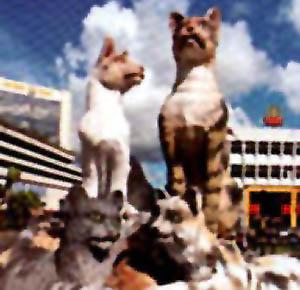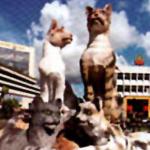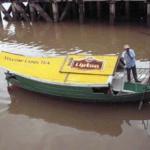The City of Cats
Kuching in Malay means cat. Thus Sarawak's state capital is known as the City of Cats. To pay homage to its feline origins there are a number of cat statues in the city. Travelers find Kuching a spotlessly clean city and coincidentally cleanliness is one of the characteristics of a cat. Visitors cannot help but notice a surfeit of garbage bins which do not overspill their contents as they are emptied frequently. Whilst Kuching is sprawling with a population of half a million people, the city center is compact. Historical sites and places of interests to tourists are mostly within leisurely walking distance.
City Center: the Waterfront
The city center is concentrated around the south bank of the Sarawak River. The most prominent Kuching landmark is the Waterfront, a well-paved promenade along the southern river bank. The Waterfront was an urban renewal development initiated in the early 1990s. The waterfront stretches one kilometer in length with the 1968-built green and white state mosque, bus terminus and wet market on its western end and the Crowne Plaza Riverside and Holiday Inn hotels on its eastern fringe. A jetty for the landing of motorized sampans (tambangs in local parlance) which ferry people across to the other bank lies in the middle of the Waterfront. The Waterfront is a ritzy and glitzy place with open-air cafes, several food and drinks stalls, a children's playground, well-manicured lawns, many park benches and two musical fountains.
Much welcomed by travelers are a booth manned by friendly and helpful policemen from the Police Tourism Branch and an air-conditioned single-storey building housing the office of the Sarawak Tourist Association with similarly courteous and resourceful staff.
At night the entire Waterfront is colorfully lit with a fairyland atmosphere. One any fine weather evening one can find many silent and contemplative figures stooping at the edge of the riverbank with their fishing lines thrown across the railing. At the break of dawn when fair weather permits the Waterfront is a hive of activity. One can observe many sweaty joggers huffing and puffing away. There are also several groups of people of Chinese origin and of all ages with their graceful Tai-chi poses moving slothfully in synch with melodious dance numbers. At the Waterfront the river traffic during the day is heavy with cargo-bearing steamers, tourist-filled river-cruisers, passenger-occupied inter-town speed-boats and school children-laden tambangs fighting for a piece of action.
Square Tower
Only two old structures in the Waterfront escaped the demolition ball and the might of bulldozers. They are the Square Tower an English-like castle structure erected in 1879 to serve as the town's jail and the Chinese History Museum constructed in 1912 as a Chinese courthouse.
The Museum houses historical notes and photographs which record the history of Sarawak Chinese migration from Kwangtung, Fukien and other southern Chinese provinces in the 19th and early 20th century. The early establishment of Chinese clan and trade associations is also interestingly documented. The Museum has a rich display of Chinese antique furniture, musical instruments and costumes. Just across the road from the Museum is the Tua Pek Kong Chinese Temple, set up in 1846 in honor of the patron deity of the overseas Chinese who had emigrated to what was then popularly known as Nanyang or South Seas. This is the oldest surviving structure in Kuching.
Just in front of the Chinese History Museum but one street away is the Hong San Temple which has an interesting history. It was built in 1897 in dedication to the memory of a Chinese boy who had distinguished himself in the Great Fire of Kuching.
Facing the Waterfront is the Main Bazaar comprising a row of century old single storey shop-houses selling local souvenirs, trinkets, handicrafts such as blow-pipes, spears, swords, baskets, sleeping/floor/table mats and rugs made from rattan, bamboo, screw-pine (pandanus species) or palm leaf strips. Many of the shops also offer various products made from Sarawak's two well-renown produce, that is pepper and sago extracted from the nipah palms (Nypa fruticans) grown wild in the lush swampy coastal areas.
Across the river
Immediately across the river from the Waterfront on the north bank are two historical colonial buildings. On the left of the jetty point is the Astana which means palace in Malay. It is a shingle-roofed, white-washed imposing edifice erected on a hill-lock. The Astana was built by the second white Rajah Charles Brooke in 1870 and it was the seat of power of the Charles Brooke and the last white Rajah, Charles Vyner Brooke. It is now the official residence of the Governor of Sarawak.
To the right of the jetty is Fort Margherita a fort with battlements sitting on a strategic knoll. Built in 1879 and named after Ranee Margherita the consort of Rajah Charles Brooke it was to guard the approach into Kuching against pirates sailing from downstream. It is currently a Police Museum.
Further away on the north bank are four Malay kampongs or villages. The fastest way to reach Kuching city center from the north bank for the kampong folks is by sampan ferry as the bridge across the Sarawak River is located a few miles away.
Two streets away from the Waterfront is the Bishop House - Kuching's oldest dwelling structure built in 1849. It is situated next door to the Diocesan Guest House a well-known place of abode for foreign travelers. These two buildings are sited within the spacious grounds of the Anglican Cathedral. There is much greenery within the compound of the Cathedral. A few beautiful rain-trees of bi-centennial vintage stand majestically within the undulating church grounds. It is nice setting to enjoy the quietude, solitude and peace as truly befitting a place of worship
Right in front of Waterfront's Tower Square is the Courthouse and the Charles Brooke Memorial. The Courthouse is an imposing structure built in 1874 and continues to this day to be used as courts. A clock tower was an added feature nine years later. Within the Courthouse compound stands a six-meter high granite obelisk erected in 1924 in memory of Rajah Charles Brooke. The vast grounds of the Courthouse play host to a number of fig trees whose fruits attract many birds throughout the day. A few walking paces away is another old building with tall Corinthian columns supporting the front entrance foundations. It houses the General Post Office. Right in front of the GPO, a quaint three-storey colonial styled building known as the Pavilion, built in 1907, serves as offices to a number of government departments.
Wet Market
The Wet Market borders the western edge of the Waterfront. It operates long hours starting when the morning has broken until dusk has fallen. Here one cannot miss the sights, smells, and sounds of people of all hues, colors and ethnicity.
On display are fresh life-stock, meat, fish, shrimps, fruits, foods, vegetables and many other local produce and products which represent a microcosm of all that Sarawak has to offer. You name anything edible you will find it here: bird nests, sharks-fins, gingers, corianders, lemon-grass, cinnamons and other kinds of spices, pineapples, bananas and many other tropical fruits, wild nuts and fruits from the forests, many kinds of meat including those from wild animals such as deer, bearded pigs, squirrels and occasionally clouded leopards although they are legally protected beings.
Across the road from the wet market is a row of old two-storey shop-houses of Indo-influenced architecture. There are still a few shops selling curry powder, spices, onions, garlic, shallots and various types of nuts and beans imported from India. This is the Indian quarter. The next street is known as India Street turned into a pedestrian mall and in between is Masjid India or Indian Mosque.
A few footsteps further west lies the Main Bus Terminus with specially allotted areas for each of the four city bus operators. Throughout the day one can see many people milling around the terminus but each one with their own purpose and intent.
Sarawak Museum
Walking along the main thoroughfare from the GPO for three to four minutes will bring one to the Sarawak Museum which has two wings connected by a footbridge across the main thoroughfare. The old (original) wing itself is a museum piece and its architecture is based on the old Normandy townhouse design.
The Sarawak Museum, established by Rajah Charles Brooke in 1891, is reputed to be one of the best in South-east Asia. He invited a well-known anthropologist, Alfred Wallace a contemporary of Charles Darwin who stayed for two years to plan and implement the opening of the Museum.
The Museum was very much identified by its association with Tom Harrisson, its curator from 1947 until the early years of Sarawak's independence in 1963. Harrisson was well known as a naturalist, archeologist and anthropologist and his distinguished achievement was his discovery of a 39,000 year old skull in one of the caves in Niah, in north eastern Sarawak.
The original Museum has a good collection of diverse exhibits. It has a large number of stuffed mammals indigenous to the island of Borneo. The most outstanding of such stuffed animals are a pair of standing Asian Wild Cattle or Banteng (Bos javanicus) which specie is close to extinction. The pair is still life-like although they could be closer to 75 years vintage.
A display of a Dayak longhouse includes skull trophies - a grim reminder of the head-hunting days. There is also a replica of a cave where swiftlets build their nests which are harvested by the natives and sold as a Chinese delicacy. Close by the cave is a glass counter containing the different types of edible bird nests. In addition there is a wide display of artwork such as brassware, Chinese jars, ceramics, antique furniture as well as the different types of native swords, spears, daggers and other weapons used in pre-colonial and colonial times for war before adventurer James Brooke the first white Rajah brought peace to the land.
Also presented are many late 19th and early 20th century photographs of natives in their traditional wear including pictures of topless native maidens. There is also a story of the discovery of oil in Miri a town in eastern Sarawak.
The New Wing is fully air-conditioned and it is intended to display exhibits showing the culture, lifestyle, traditions of the many different groups of natives of Sarawak.
In January 2003 there was an exhibition of head gears. A wide range of head gears was displayed ranging from helmets which formed part of the accessory worn to wage wars to those worn in pursuit of sports and recreation and from head pieces adorn with colorful trimmings, beads, baubles and feathers used for ceremonial dance rituals to austere and dowdy turban worn to reflect religious piousness.
At the back of the new Wing but fronting another street is the Islamic Museum. It occupies the premises of a former Moslem religious school. It has 7 galleries and the exhibits portray a diverse Islamic culture ranging from art and architecture to weaponry and from paintings and tapestry to coinage. There are also exhibits signifying Islamic contributions to science, astronomy, music and literature
Kuching North
To the north of Kuching city is a satellite township known as Kuching North. Here there is one museum which is one-of-its-kind in the world. It is known as the Cat Museum. It is a bit too far to walk but one can take a public bus to reach the Museum. The journey takes perhaps 10 minutes. The Museum is housed in an UFO-shaped DBKU Building. It is the acronym for Dewan Bandaraya Kuching Utara which means City Hall North Kuching. The Cat Museum pays homage to the name of the city. It has exhibits comprising trivia, photos, children paintings and movie posters depicting cats. It is a place for kitsch and fun.
Kuching is indeed a popular tourist destination. It has many visitors from other parts of Malaysia and abroad not only because it is the main gateway into Sarawak it has many places of interests within the city and there are a number of beach resorts, national parks and wildlife reserves accessible by day-trippers. Kuching too is a tourist-friendly city with many directional signs, pedestrian malls, sidewalks and tree-lined streets, information booths maintained by the state-run Sarawak Tourism Board, private-sector Sarawak Tourist Association and the Tourism Branch of the Police Department. Kuching's feline charm and grace attract visitors and travelers from near and afar.
* * * * *
 ThingsAsian
ThingsAsian


















